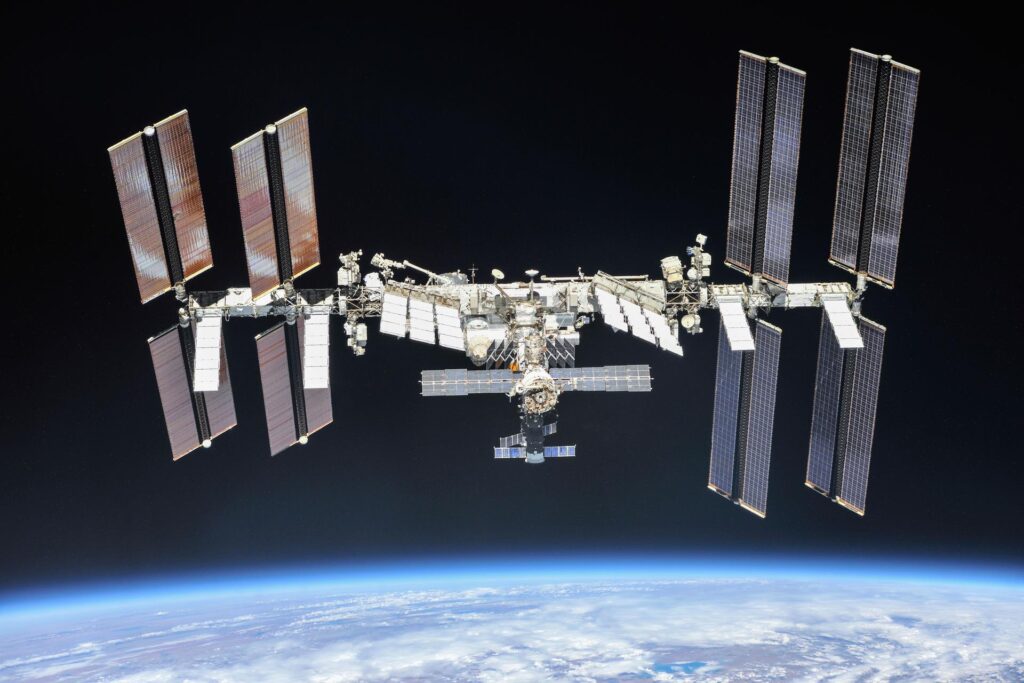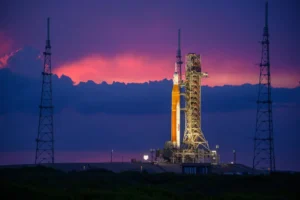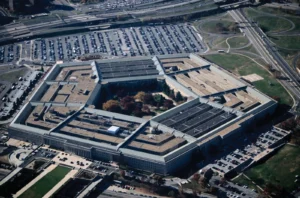The International Space Station: Humanity’s Home Among the Stars
Imagine a place, about 400 kilometers above Earth, racing around the planet at an incredible 28,000 kilometers per hour. This isn’t science fiction; it’s the International Space Station, or ISS for short. It’s truly the biggest and most complex structure humanity has ever managed to assemble in space. For over two decades, it’s been a unique outpost for cutting edge research and, perhaps even more importantly, a testament to international collaboration. While the astronauts aboard monitor climate change and perform experiments that could genuinely change life on Earth, there are also those “bad days” – like having to use duct tape to fix a high voltage solar panel dangling from a robot arm in the deadly vacuum of space. It’s a place of incredible achievements, but also constant challenges.
| Achievements / Benefits | Challenges / Risks |
|---|---|
| Transnational research outpost for climate change and scientific experiments. | Extreme temperatures (120°C to -160°C) requiring complex thermal control. |
| Symbol of international collaboration (15 nations, including US and Russia). | Zero atmosphere, crushing cold, scorching radiation, and fast moving debris. |
| Groundbreaking biomedical studies (e.g., bone loss, cancer/heart disease research). | Limited resources (e.g., water recycling from sweat/urine, no showers). |
| Development of Earth based drugs (e.g., Prolia for osteoporosis). | Logistical complexities of docking modules and spacewalks. |
| Advancement of plant growth research in microgravity. | Aging systems (AC issues, oxygen system acting up, air leaks). |
| Demonstrates human ingenuity and problem solving in extreme conditions. | High stakes operations; razor thin margin of error. |
Life Aboard the ISS: Daily Routines and Peculiarities
What’s it actually like to live in space? Well, it’s certainly not your typical nine to five. Imagine waking up in a sleeping bag strapped to the wall of your small, windowless cabin. The lights are off, providing some much needed bio rhythm, while the station hurtles through space. Every 45 minutes, the sun either goes up or down. That’s right: 16 days squeezed into 24 hours. Talk about a jolt to your system!
At 6:00 a.m. sharp, it’s time to rise. Our hypothetical astronaut, let’s call him “Alex,” has about 10 hours of work ahead. His first challenge? Waking up in zero gravity. He pulls out his earplugs, and the constant hum of fans and machines hits him – it’s as loud as a busy city street. Without proper ventilation, the carbon dioxide Alex exhales would just linger around his head, potentially suffocating him in his sleep. In zero gravity, fluids behave strangely too; they’re not pulled down by weight, so faces can puff up and noses might run.
Toilets up here rely on suction to keep, shall we say, certain things from floating away. Most of the human deposits end up in sealed bags, which are then vacuum dried, wrapped in waste capsules, and shot into space. Some of them actually burn up in the atmosphere, looking a bit like shooting stars. Make a wish, perhaps?
Alex wipes himself down. There are no showers up here because water is incredibly precious. Nearly all of it is recycled from sweat, breath, and even urine. A high tech filtration system turns 98% of it back into drinking water – that’s at least 6,000 liters per year! Alex uses that system to fill his drinking pouch. He then gets dressed in the same clothes he’s worn for days; his dirty laundry also eventually turns into a potential shooting star.
He doesn’t need a sweater, anyway. Parts of the station can get scorching hot, up to 120 degrees Celsius, when facing the sun. Inside, the thermal control system is working at full power to keep the crew from getting baked. A passive system uses insulation, surface coatings, heaters, and heat pipes to balance extreme temperatures. An active system uses water and ammonia. Water based cooling loops absorb heat generated by the crew and electronic equipment. This heat is then transferred to heat exchangers and passed to ammonia circuits that pump it out to giant radiators, which then release it into space. This system keeps inside temperatures at a manageable maximum of 24 degrees Celsius, and they never go below 18, even when the ISS swings into Earth’s shadow, where outside temperatures plummet to a crushing minus 160 degrees Celsius. On the ISS, survival really does depend on remote control and perfectly functioning systems.
After getting ready, it’s breakfast time. Alex has no idea how much he’ll need it today. Scrambled eggs, rehydrated from a plastic pouch. Coffee, though, is a small miracle. Alex can actually sip it from a specially designed zero gravity cup, where the liquid literally clings to the rim and climbs into his mouth via surface tension. He shares this moment with “Dmitri,” his coffee buddy and crewmate from Russia. Despite geopolitical tensions and decades of mistrust, Russians and Americans still work on this station together – a fragile alliance held together by science, diplomacy, and, well, caffeine. The rest of the international crew trickles in, mostly fellow Americans and Russians, but also Europeans, Canadians, and Japanese. Then comes the morning briefing, where the crew discusses the daily agenda in a live feed with five ISS ground control centers around the world.
- Orbit: 28,000 km/h, 400 km above Earth, 90-minute orbits (16 sunrises/sunsets daily).
- Environment: Constant hum of machines, CO2 circulation for air quality, fluid shifts (puffy faces).
- Waste Management: Suction toilets, waste sealed, vacuum dried, and ejected as “shooting stars.”
- Water Recycling: 98% of water recycled from sweat, breath, and urine (6,000 L/year). No showers.
- Clothing: Worn for days, dirty laundry also ejected.
- Temperature Control: Maintains 18-24°C inside despite external extremes (120°C to -160°C) using passive and active systems.
- Food & Drink: Rehydrated meals; special cups for zero gravity coffee (surface tension).
- International Crew: Collaboration among 15 nations, including US, Russia, Europe, Canada, Japan.
- Daily Briefing: Live feed with five global ground control centers.
A Monument to Collaboration: Building the ISS
The ISS isn’t just a place; it’s an incredible feat of engineering and international cooperation. It’s the biggest and most complex structure humanity has ever assembled in space, built by 15 nations, including the United States and Russia, who, despite their differences on Earth, work side by side up there.
The station, as we see it today, is made up of 16 pressurized modules where the crew can float around without their space suits. The backbone holding it all together is the integrated truss structure – a linear arrangement of 11 steel trusses that carries unpressurized components, like the giant solar panels, and connects them to the living modules.
The very first module was Zarya, a 12.6 meter long, 20 ton piece built in Russia. The Americans added the connecting node, Unity, shortly after. The first living quarters, called Zvezda, arrived in July 2000, and that’s when the first three astronauts could finally move in. It took over 40 shuttle flights and more than 20 years to put together the ISS in its current form. That’s a long time, isn’t it?
The station roughly splits into two main blocks: one Russian and one American. The Europeans plugged in their Columbus laboratory, and the Japanese added their Kibo laboratory. But the real showstopper, for many, is Canada2, a 16 meter robotic arm that can grab modules, move them around, and even hold astronauts during spacewalks. It can relocate itself along the station and move to wherever it’s needed, which is pretty clever.
The ISS features six research labs, two living quarters, and a panoramic observation cupola – a place where astronauts can literally look down at Earth. Plus, there are endless connecting nodes, storage compartments, and technical systems. The interior volume is about the size of a Boeing 747. With its solar arrays fully extended, the station covers a surface area of roughly 7,000 square meters. Its 260,000 solar cells across two and a half thousand square meters constantly rotate to track the sun. Backup batteries take over whenever the station swings into Earth’s shadow, ensuring continuous power.
Just recently, a new Russian module, the “Prichal,” was successfully docked. This four ton module has six docking ports for more modules and Russian spacecraft to plug in later. Everything ran smoothly during its arrival, a testament to the precision required for such high stakes operations.
- Structure: 16 pressurized modules, integrated truss structure (11 steel trusses).
- Key Modules: Zarya (Russian, first), Unity (US), Zvezda (first living quarters), Columbus (European), Kibo (Japanese), Prichal (new Russian module with 6 docking ports).
- Construction: Over 40 shuttle flights, 20+ years to assemble.
- Robotic Arm: Canada2 (16m, moves modules, holds astronauts, relocates).
- Size: Interior volume like a Boeing 747; solar arrays cover 7,000 m².
- Power: 260,000 solar cells (2,500 m²) track the sun; backup batteries for shadows.
Science in Orbit: Research That Changes Life on Earth
The ISS isn’t just a giant orbiting puzzle; it’s a bustling laboratory. It features six dedicated research labs, and the science conducted there is truly groundbreaking, with potential impacts right here on Earth.
Take, for instance, the mice experiment. Fifteen mice are aboard, and they’ll never truly understand why they suddenly started floating. But they’re part of a groundbreaking experiment. These mice were injected with special antibodies back on Earth, and researchers like Alex observe how those antibodies affect their bone growth in zero gravity. Weightlessness, you see, tends to accelerate bone loss. So, these are the perfect conditions to stress test potential treatments. In fact, this very experiment is directly contributing to developing “Prolia,” a drug already used to combat osteoporosis on Earth. It’s pretty amazing to think that research done hundreds of kilometers above us can directly improve human health here.
Next stop: plants. This little wheat plant, Arabidopsis thaliana (also known as cress or mouse ear cress), might seem inconspicuous on Earth, but it’s a star up here in space. Plants usually exhibit growth responses to light and gravity. But in orbit, gravity disappears. So, what happens? On Earth, roots spiral down and leaves reach up. In space, the plant goes wild, growing everywhere at once. The ISS crew is constantly conducting research, from physics experiments to biomedical studies that may one day help treat cancer or heart disease. Some of that science could genuinely change life on Earth.
- Research Labs: Six dedicated labs for various experiments.
- Bone Loss Study: Mice injected with antibodies to test treatments for bone loss in zero gravity, contributing to osteoporosis drug development (e.g., Prolia).
- Plant Growth: Observing how plants (like Arabidopsis thaliana) grow without gravity, showing wild, undirected growth.
- Broad Impact: Research spans physics and biomedical studies with potential for treating diseases like cancer and heart disease.
The Ultimate Spacewalk: Repairing a Damaged Solar Panel
Sometimes, the science has to take a backseat to more immediate, and incredibly dangerous, concerns. The morning briefing revealed a pressing issue: one of the ISS’s vital solar panels was damaged, with two tears, one nearly a meter long. Since the station runs entirely on solar power, reduced input means throttled systems and possible shutdowns. Someone, clearly, had to go out and fix it. This operation would go down as the most dangerous spacewalk in ISS history.
Two real life astronauts, “Scott” and “Doug,” volunteered for the job. Before the spacewalk, they were inside the Quest module, the airlock. The pressure inside slowly dropped to match the cosmic vacuum outside. They secured their safety tethers, making absolutely sure they wouldn’t drift off into the abyss. Then, the hatch opened, and they stepped out into space.
They were heading toward the torn solar array, but they had no proper tools or replacement parts. Instead, they had just five makeshift braces they had put together with aluminum strips, wire, and duct tape. No one knew if it would even work. The panels were still live, carrying 100 volts of exposed current. An electric shock could be fatal. Every single metal part of Scott’s suit and tools had been triple wrapped in insulating tape as a precaution.
Then there was the distance. The damaged panel was farther from the airlock than any ISS astronaut had ever ventured. Scott would be the first. The Canada2 robotic arm was too short, so the crew had to add a 15 meter extension, making it even more difficult for Alex and his crewmate to guide the arm from the inside.
Scott’s boot was locked in, and the arm began its slow crawl toward the damaged solar panel. It took some time. Scott was suspended over Earth, floating around 400 kilometers above the Amazonian rainforest. He felt, as he later described, like a tiny worm stuck to a fishing rod, strapped to a metal beam extended into infinity. Over the comms, his crewmates walked him through the list of dangers to consider, like sharp edges and the live voltage.
Then he finally arrived. The tear was right there. Scott got to work again. Everyone was holding their breath, both aboard the ISS and on the ground. They were watching Scott’s every move in total silence. One by one, he slipped the handmade braces through the holes in the fabric, like cufflinks, pinning fragile metal into place. It worked. The braces held. The entire crew breathed a collective sigh of relief. It was a moment of incredible tension and ultimate triumph.
- Problem: Damaged solar panel with significant tears, threatening the station’s power supply.
- Astronauts: Scott and Doug undertook the repair.
- Makeshift Tools: Used five handmade braces made from aluminum strips, wire, and duct tape.
- Extreme Risks: Live 100V current (fatal shock risk), unprecedented distance from airlock, extended robotic arm for reach.
- Successful Repair: Scott successfully installed the braces, restoring functionality and averting a potential crisis.
The Future of the ISS: An Enduring Legacy
The ISS has been up there for more than 25 years now, and, like any long serving structure, it’s starting to show its age. The air conditioning keeps “botching,” and the oxygen system acts up sometimes. Air escapes, and no one really knows from where. It’s a testament to the ingenuity of the engineers and astronauts that it continues to function so well despite these issues.
But all good things, even those orbiting Earth, must come to an end. By 2030, the 420 ton satellite is planned to make its final descent into the ocean. It will be a controlled closure to a stellar chapter of human collaboration and engineering, a falling star guided back to its home planet. It’s a planned and controlled end to an incredibly ambitious project.
Alex, our astronaut, is grateful for every minute in orbit, but he’s also ready to come home. To his family, to gravity, and to a proper pizza – one that leaves crumbs everywhere. And, of course, a long, hot shower to rinse them off. Outside, the sun sets for the 13th time today, marking another day in humanity’s remarkable home among the stars.
- Aging Station: Over 25 years old, experiencing issues with AC, oxygen system, and air leaks.
- Planned Deorbit: Scheduled for a controlled descent into the ocean by 2030.
- Legacy: Represents a significant chapter of international human collaboration and engineering.
- Astronaut Perspective: Despite the wonders of space, astronauts look forward to simple comforts of Earth.
Key Takeaways and Summary
The International Space Station stands as a monumental achievement, a complex orbiting laboratory built by 15 nations, symbolizing global cooperation in science and engineering. Life aboard is far from ordinary, marked by the peculiarities of zero gravity, meticulous resource recycling (including water from sweat and urine), and constant maintenance of life support systems against extreme environmental conditions.
The ISS is a hub for vital research, from understanding bone loss and developing treatments like Prolia, to studying plant growth in microgravity, all contributing to advancements that benefit life on Earth. Its operational history is filled with high stakes moments, none more dramatic than the spacewalk to repair a damaged solar panel using makeshift tools, a testament to the crew’s ingenuity and bravery.
As the ISS approaches its planned deorbit by 2030, its legacy as humanity’s longest running orbital outpost and a beacon of international scientific endeavor will endure. It reminds us of both the incredible challenges and profound rewards of pushing the boundaries of human exploration.
Key Important Points:
- Global Collaboration: The ISS is a unique project built and operated by 15 nations, showcasing international unity in space exploration.
- Extreme Environment: Astronauts face challenges like zero gravity’s effects on the body, extreme temperatures, and the need for rigorous life support systems.
- Groundbreaking Research: The station hosts experiments in biology, physics, and medicine, leading to discoveries that can improve life on Earth (e.g., osteoporosis treatment).
- Operational Resilience: Despite its age and the harshness of space, the ISS and its crew demonstrate incredible adaptability and problem solving, as seen in critical repairs like the solar panel fix.
- Enduring Legacy: Scheduled for a controlled deorbit by 2030, the ISS will leave behind a rich legacy of scientific advancement and human ingenuity in space.





